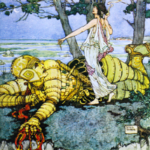On Ancient Myths, Modern Robots and High-tech Imaginings

When I was a kid, I loved watching the reruns of the 1963 movie Jason and the Argonauts. My friends and I lived for the scenes in which the human characters battle the various monsters created through the magic of stop-motion animation. There’s still nothing like them. Somehow modern CGI-animated scenes just don’t have that same cinematic magic when it comes to sword-fighting with scowling skeletons.
One of scenes I liked best (aside from the sword-fighting skeletons) is where Jason exsanguinates Talos, the giantic bronze statue that eerily comes to life. Stop-motion is especially convincing when it comes to animating things that are supposed to be artificial to begin with. According to Greek myth, Hephaestus, the Greek god of blacksmiths and artisans, built Talos at the request of Zeus.
In the original myth, Talos was supposed to protect Europa, whom Zeus kidnapped and brought to the island of Crete. (I’m not sure if he was supposed to protect her from other wannabe kidnappers or from rescuers, but maybe we’ll take that up in a future blog on Europa, after whom the continent of Europe was named).

From Swords and Sandals, “The Creatures of Jason and the Argonauts”
Anyway, I don’t remember Europa being in the movie. I think they just stumbled onto the island because, well, they needed to fight a gigantic bronze monster.
In the movie, Jason kills Talos by unscrewing a round port in the giant’s heel to let the molten lava-like ichor (that is, the blood of the gods) drain out. Thinking back, that round port bears a strong resemblance to the compartments where we store batteries in lots of our modern devices.
Of course, that’s the made-for-TV version. In mythology, it’s often Medea, Jason’s wife, who kills Talos by removing a nail in his heel. That also led to to deadly ichorlessness.
The bottom line, though, is that Talos is essentially a robot built to be a security system for a whole island. When I was a kid, I understood his essential innocence and felt kind of bad for poor Talos, who was just doing his pre-programmed job. (He dies pretty gruesomely, if I recall correctly, grabbing at his giant throat as if he’s strangling to death.)
But what I didn’t appreciate as a kid was that Talos was just one of many “robots” to appear in mythology. There’s now a whole book devoted to the subject: Myths, Machines, and Ancient Dreams of Technology, by Adrienne Mayor.
Writing in the Weekly Standard, William Wilson notes:
Greek myths as [Mayor] tells them are overflowing with robots. Robot sentinels like Talos, ferocious killer robots like the Stymphalian birds, sinister androids like Pandora, robotic assistants like Hephaestus’ forge helpers, and on and on. What makes such things robots? Mayor offers two criteria: first, that they are of mechanical rather than biological construction, and second, that they are the products of conscious artifice. The Greeks, she argues, envisioned and described these beings as advanced technological artifacts driven by internal machinery and following rational principles of operation.
As I suggested in an earlier blog on the topic of Mimir (who is a character in the The Tollkeeper), ancient myths often anticipate current and future technologies because they give expression to our visions of what’s possible and desirable. Flying humans? Check out Daedalus. Instant messaging? Check out Mercury.
The robots of mythology are just another case in point. If we want to better understand the promise and perils of artificial intelligence and robots, we should start there and then work ourselves up to the present moment. It is, after all, just one long, mythic narrative. Yesterday’s blacksmith Greek god is today’s Silicon-valley billionaire uber nerd. When you look at it from that perspective, it doesn’t seem like such a big leap.
Feature image: Medeia and Talus by Sybil Tawse
The post On Ancient Myths, Modern Robots and High-tech Imaginings appeared first on The Tollkeeper.



